PV column
Photovoltaic
2023/03/01
Guidelines and Opinions on Fire in Photovoltaic system
The amount of photovoltaic systems installed is increasing worldwide, partly due to soaring electricity costs, decarbonization, and various other goals of renewable energy adoption. In Japan, as in many other countries around the world, an increasing number of local governments and companies are becoming eager to introduce and utilize photovoltaic systems, and are considering installing photovoltaic systems on the roofs of homes, factories, warehouses, and other buildings.
On the other hand, there seems to be a lot of information in Japan that stirs up anxiety about fires related to photovoltaic systems without actually checking the guidelines and various guidelines of the Fire and Disaster Management Agency and the Agency for Natural Resources and Energy.
In this column, we will focus on the Tokyo Fire Department’s guidelines, which are the most well-known regarding firefighting for photovoltaic facilities, as well as related information.
**********
Please refer to Chapter 5, 6 and 7 in “Results of Examination of Fire Safety Measures for Photovoltaic system” by Tokyo Fire Department and “Guidance Standards for Fire Prevention and Safety Measures for Photovoltaic system and equipment” by the Tokyo Fire Department, as well as the following. These reports are only available in Japanese.
1. Summary of “Results of Examination of Fire Safety Measures for Photovoltaic system”:
- Chapter 1. Purpose of the study, etc. (Japanese version only)
- Chapter 2. Summary about Photovoltaic system (Japanese version only)
- Chapter 3. Current status about Photovoltaic system (Japanese version only)
- Chapter 4. Issues related to Photovoltaic system (Japanese version only)
- Chapter 5. PV module combustion test (Japanese version only)
The following is a summary of Section 4 of this chapter. Please refer to the documents in Section 5 for further details.
Chapter 5, section 4 summary
From the test results, the combustion properties of PV modules heated from fires elsewhere can be summarized as follows.
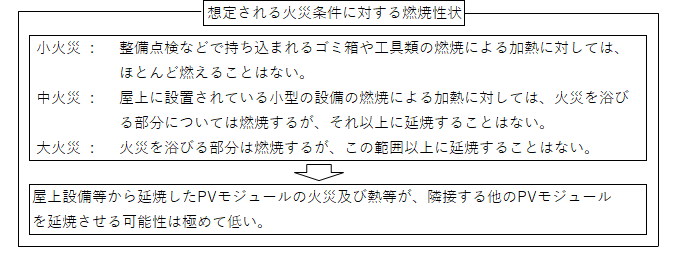
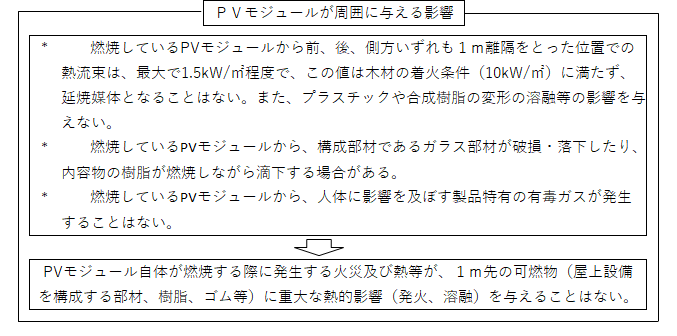
All of the combustibility properties are characterized by the low amount of combustible materials in the PV modules, and we confirmed that the PV modules tested in this study have the above combustibility properties within the range of combustible material conditions (less than 2000g of combustible material per unit area of 1m2).
It is necessary to consider separately how to deal with falling or dripping combustion materials.
- Chapter 6. Danger of electric shock during firefighting activities (Japanese version only)
- Chapter 7. Fire safety measures for Photovoltaic system (Japanese version only)
The following information is provided in Section 2 of this chapter, “3 Installation Methods in Active Facilities Ensuring Firefighting Safety” and “5 PV Module Placement Ensuring Firefighting Safety”.
3 Installation Methods in Active Facilities Ensuring Firefighting Safety”
To ensure the safety of firefighting activities, no PV modules should be installed in the vicinity of the activity facility. When unavoidably installing the PV system in the vicinity of an activity facility, a protective device, etc. are required to prevent electric shock.
The installation of PV modules to ensure safety during firefighting activities is as follows:
(1) Emergency entrances and outdoor stairs
(a) In principle, PV modules are not installed. However, if there is no risk of damage to the PV module, such as if it is protected by BIPV type or metal frame with sufficient strength, installation is possible.
(b) Do not lay DC wiring, etc. within the area where there is a risk of contact (approx. 50cm around the facility). However, if the unit is protected by a metal pipe, etc. and there is no risk of damage, installation is possible.
(2) Emergency access door (alternative opening) No PV modules (window material type) are used in the windows.
5 PV Module Placement Ensuring Firefighting Safety
We studied the buildings divided into two categories: those subject to fire protection other than houses and row houses that are subject to the Fire Service Law and other regulations (hereinafter referred to as “buildings other than houses, etc.”) and houses and row houses.
Fireproof buildings other than residences, etc., were classified into two categories: large-scale roofs with PV modules generally having an installed area of 300m2 or more, and roofs with PV modules having an installed area of less than 300m2. The reasons for the classification by 300m2 are as follows:
The maximum horizontal water discharge range of the gun-type nozzle used by fire fighters of the Tokyo Fire Department is approx. 24m. The approx. maximum array area that the water discharge can reach all PV modules is assumed to be a square area with 24m as the diagonal, which is roughly 300m².
Houses and other structures were classified into two categories: roof-mounted and roof-built.
(1) Fireproof buildings other than residences, etc.
Roofs requiring installation methods to ensure the safety of firefighting activities are generally sloped roofs, including rooftops and flat roofs, where “maintenance corridors” are provided. Roofs with no risk of slipping are excluded from the scope.
“Maintenance corridor” means a corridor provided on a roof for maintenance of PV modules or other equipment. The “maintenance corridor” is a corridor for firefighting activities such as easy access to the PV module (a part without PV module that can be used for firefighting activities such as water spraying, hose extension, and material and equipment transport, etc.; hereinafter referred to as “corridor for firefighting activities”). Any width, spacing, etc. shall not be required as long as they have approximately the same function. A “no-slip roof” refers to a roof with a fall-prevention wall or fence.
The following is a method of placing PV modules on the roof that ensures safety during firefighting activities.
A. Large-scale roofs (PV module footprint generally over 300 m²)
(1) A passageway for firefighting activities with a width of approx. 1m shall be provided. When cable racks, etc. are laid in such a passageway area, those whose tops can be walked on by means of lids or bridges, etc. shall be included in the width.(2) Fire-fighting passageways shall be laid out in consideration of the access of fire-fighting teams, such as for leaning against a ladder truck, etc.(3) Firefighting passageways should be located so that the distance between all PV modules is within 24m (the maximum horizontal water discharge range of gun-type nozzles (nozzle pressure 0.5 MPa, water discharge 110 L/min)) (see Fig. 7-5).
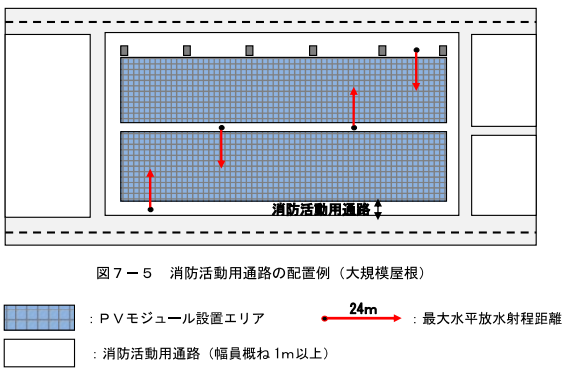
B. Other than large roofs
In consideration of firefighting activities, a space effective for ensuring the safety of firefighting activities on the periphery of the roof, etc. (a space without a PV module, hereinafter referred to as “activity space”). The space for firefighting activities shall be secured by serving as an effective space for ensuring safety of firefighting activities (the part without PV modules.)
However, no activity space is required for building openings (e.g., windows) and areas where the PV module can be accessed from the north roof, etc., where no PV module is installed.
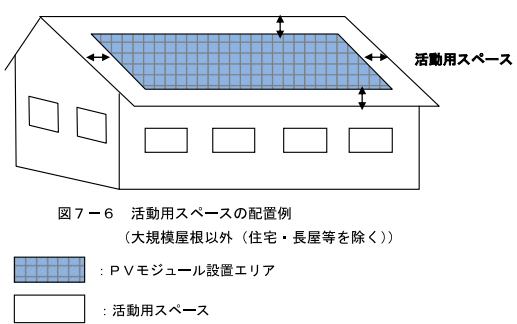
(2) Houses, etc.
A. Roof-mounted type
Generally, roofs of houses and other structures often have a certain amount of open space around the perimeter of the roof, in accordance with standards for wind load capacity based on the Building Standard Law (see Figure 7-7) or voluntary standards for maintenance, etc. established by each manufacturer (see Table 7-2).
Since open space contributes to the safety of firefighting activities, it is necessary to require for design and construction that takes such securing into consideration. If the PV module can be accessed from building openings (windows, etc.) or from the north roof where the PV module is not installed, it is not necessary to provide an open space.
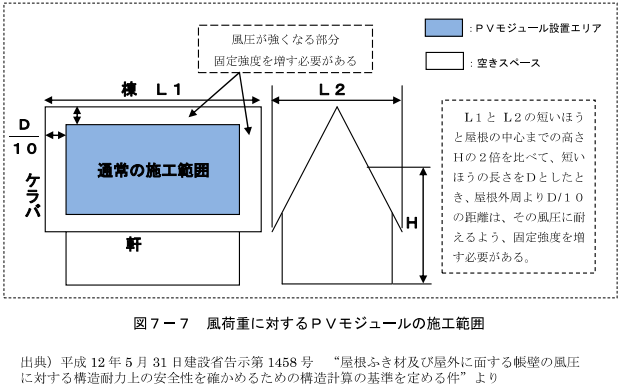
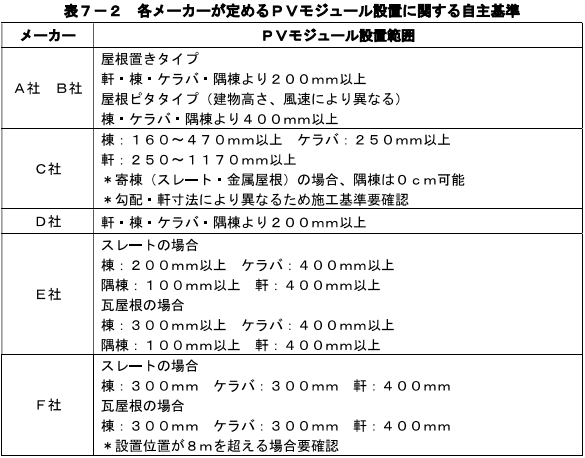
B. Roof Building Material Type (BIPV)
In the roof building material type, the entire surface of the roof can be covered with PV modules (see Figure 7-8). Currently, an increasing number of houses have PV modules covering the entire surface of the roof in order to generate more power. It is difficult to secure free space on the roofs of such houses for the safety of firefighting activities. Therefore, safety measures other than open spaces are desired so that firefighters can operate safely on the roofs.
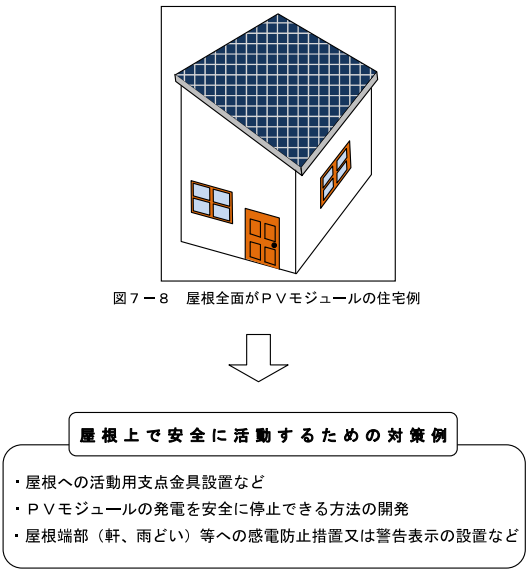
- Chapter 8. Summary and Future Issues (Japanese version only)
2. Guidance Standards for Fire Prevention and Safety Measures for Photovoltaic Power Generation Facilities:
The following is a summary and details of the “Guidance Standards for Fire Safety Measures for Photovoltaic Power Generation Facilities ( Japanese version only )” published by the Prevention Division of the Tokyo Fire Department on July 14, 2014.
In 2013, the Tokyo Fire Department established a subcommittee to study fire safety measures for photovoltaic power generation facilities with outside experts, and compiled the necessary fire safety measures for buildings where the facilities are installed.
Based on the above study, we have recently established the Guidance Standards for the Installation of Photovoltaic Power Generation Facilities in Fire Prevention Objects listed in Appendix Table 1 of the Fire Service Law Enforcement Order (Cabinet Order No. 37 of 1961), which will be in operation as of October 1, 2014. The outline of the Guidance Standards is as follows. The details of the guidance standards are available on the Tokyo Fire Department’s website (http://www.tfd.metro.tokyo.jp).
(1) Limited installation around facilities utilized by firefighters (see Figure 1)
No PV modules, DC wiring, etc. shall be installed in outdoor stairways, emergency entryways, alternative openings, and approximately 50cm around them.
(2) How to install PV modules on the roof (see Figure 2)
For large-scale installations, firefighting pathways shall be installed so that the distance between all PV modules is within 24m.(3) Installation of PV modules in locations restricted by fire service laws (see Figure 3)
PV modules that meet certain conditions can be installed around rooftop facilities in restricted areas where building equipment cannot be installed due to fire service laws and regulations.(4) Electric Shock Prevention Measures Required for Fire Prevention Objects (See Figure 4)
Signage, etc. shall be provided to reduce the risk of electric shock to firefighters during firefighting activities.
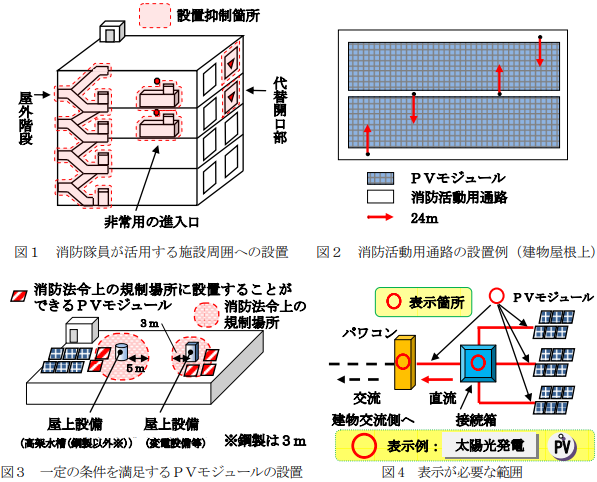
Guidance standards for this content can be downloaded here (Japanese version only)
**********
There are many published materials on photovoltaics and firefighting in the U.S. and Germany, where photovoltaics is widely used. Please contact us if you are interested.

